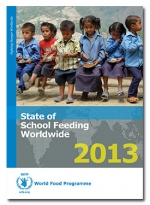A Meal In School Is A Powerful Tool, Finds State Of School Feeding Worldwide 2013 Report
30 November 2013
Countercurrents.org
 The World Food Program finds: The coverage and quality of school feeding programs vary with national income. In low-income countries, where the need is greatest in terms of hunger and poverty, the coverage is the lowest.
The World Food Program finds: The coverage and quality of school feeding programs vary with national income. In low-income countries, where the need is greatest in terms of hunger and poverty, the coverage is the lowest.
The WFP finding has been presented in its report State of School Feeding Worldwide 2013 report.
The report, a first time similar approach, presents the global picture on the issue.
It shows an estimated 368 million children receive a meal at school every day, both in developing and affluent countries. The global investment is in the order of US$75 billion a year.
Done in partnership with the World Bank and the Partnership for Child Development, the
State of School Feeding Worldwide 2013 presents our current understanding of school feeding through a global survey, maps, case studies and analysis.
The report follows up from the landmark 2009 publication Rethinking School Feeding, to provide new insights into the policy and management of school feeding programs globally.
Since the financial crisis in 2008, interest in school feeding has grown among both high- and low-income countries, highlighting the need to improve our knowledge and our evidence base.
The WFP report said:
“Linking school feeding to local agricultural production is seen as a way to ensure sustainability and take advantage of a range of potential benefits.”
It said:
“Countries are exploring ways to purchase locally, in particular from smallholder farmers to provide them with a stable market for their products and potentially to increase their incomes. They are also empowering school-level committees to purchase food closer to the schools, so that the community is involved in making decisions and managing resources.”
It added:
“Local procurement can also be an opportunity to provide more diverse foods, including those that are fresh and unprocessed. These efforts include providing indigenous crops, like the cereal quinoa in the Andes and several types of banana in Asia that are closer to what children may eat at home. This has the potential to increase the quality of the food basket. Another new area is including products like beans or rice that have been biofortified; this means that they have more than the normal amount of micronutrients, which may be more nutritious.”
The report observed:
“There is growing excitement around the idea that school feeding programs that use food produced and purchased locally, or at least within the boundaries of a country, can generate additional benefits for the children involved and also for local farmers, communities and economies.”
The report said:
“Poor people are disproportionately at risk of losing their homes, their livelihoods and their assets because of unemployment or sickness of a family member. People already living in poverty are less able to bounce back or recover from the effects of a financial crisis, spikes in food and fuel prices, conflict, disasters, droughts or floods. After being hit by these events several times, they become less and less resilient. They also resort to negative coping strategies, such as taking their children out of school, often to have them work. Any gains made in the past are quickly lost to a downward spiral of chronic poverty and vulnerability.”
Key findings of the report include:
1. The greatest opportunities for containing costs are in low-income countries – in some countries school feeding per child costs more than education itself and there is opportunity for efficiency savings.
2. School feeding works as part of social protection systems to support the most vulnerable families and children and can be scaled up in response to crises. At least 38 countries surveyed have scaled up their programs in response to armed conflict, natural disasters, and food and financial crises.
3. School feeding contributes to having healthy and well-educated children, but can only help if teachers, textbooks, curriculum and an environment conducive to learning are also in place.
4. Addressing the nutrition needs of school-aged children can help ensure that the development gains in the crucial first 1,000 days of life are not jeopardized by later failures.
The report addresses the following questions:
1. How can countries improve the effectiveness and efficiency of the programs they are already implementing?
2. How do school meals contribute to social protection, education and health goals?
3. How do governments support the link between local agricultural production and school meals to make programs sustainable?
4. How can school feeding programs better support the most vulnerable families and children in any society?
Comments are moderated
